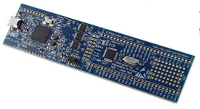You are here
Starting with LPCXpresso
 After several years without developing low-level software, I was missing close contact with hardware. A few months ago, I answered the request of a friend of mine, looking for a specific product not available on the market. I realized a proof of concept for him, which led me going back to use a soldering iron, to assemble a small number of components (mainly an LDO regulator, a Bluetooth module and a few wires...)
After several years without developing low-level software, I was missing close contact with hardware. A few months ago, I answered the request of a friend of mine, looking for a specific product not available on the market. I realized a proof of concept for him, which led me going back to use a soldering iron, to assemble a small number of components (mainly an LDO regulator, a Bluetooth module and a few wires...)
But that was not enough  . So, last week, I ordered an LPCXpresso 1115 board, and an LPCXpresso Experiment Kit. Of course, I did not choose the LPC1115 at random. At a functional point of view, I have several functional targets in mind. At a technical point of view, I was hesitating between a PIC microcontroller, and something based on an ARM core.
. So, last week, I ordered an LPCXpresso 1115 board, and an LPCXpresso Experiment Kit. Of course, I did not choose the LPC1115 at random. At a functional point of view, I have several functional targets in mind. At a technical point of view, I was hesitating between a PIC microcontroller, and something based on an ARM core.
I discovered Microchip's PIC family more than twenty years ago, and got the opportunity to develop a prototype using one of their microcontrollers, but no more. Anyway, I really appreciated the architecture, product simplicity, and low cost. Apart from this, some time before, I had been the proud owner of an Acorn BBC, a fantastic microcomputer. Acorn's technical team, several years after BBC microcomputer launch, would deliver to the market another technical marvel: the ARM architecture...
So, deciding between PIC and ARM was not easy: I had sentimental connections with the two of them  . I asked a friend a mine, who is far more hardware oriented than me. Given my functional requirements, we decided that the ARM target was the good choice. He had some experience with NXP's LPCXpresso, and was happy with it. So, I selected this one...
. I asked a friend a mine, who is far more hardware oriented than me. Given my functional requirements, we decided that the ARM target was the good choice. He had some experience with NXP's LPCXpresso, and was happy with it. So, I selected this one...
I ordered an LPC1115 LPCXpresso and an LCPXpresso Experiment Kit from Mouser, along with some additional components. The two LPCXpresso sets are designed by Embedded Artists, and supported by Code Red Technologies IDE. Three days later, I received my order.
This article contains notes I take down while developing my first project...
Setting up the development environment
I use a MacBook Air, where Eclipse is already installed. But I'll see later that Eclipse is not a pre-requisite: Code Red IDE installation brings with it everything that is needed.
- go to http://lpcxpresso.code-red-tech.com/LPCXpresso and create an account
- download LPCXpresso for Mac OS X (current version is 5.2.6 build 2137)
- while downloading, register at NXP support forum. Create an account on Embedded Artists web site as well, and register the Experiment Kit.
- install LPCXpresso
- activate the product
In order to use subversion from within Eclipse / LPCXpresso, add Juno software site: http://download.eclipse.org/releases/juno (Help / Install New Software...). Then, install Subversive, adding Subversive SVN Team Provider, Subversive SVN JDT Ignore Extensions, Subversive Revision Graph.
Building a first example
- connect the LPCXpresso to a USB port. No cable is delivered with the LPCXpresso. Thanksfully, the Experiment Kit includes one. A red LED starts flashing, at a rate of about two flashes per second...
- examples that were listed on NXP's web site are now part of the IDE. They can be found in the Examples directory. Import 11xx examples, from the zip file.
- choose an example, blinky for instance. Via project properties, select target MCU (C/C++ Build / MCU settings): LPC1115/303
- click on Debug 'blinky' in the Quickstart panel: the code is compiled, linked, loaded and started in debug mode. Click on Run / Resume: it runs.
When I think at amounts of time and money I had to invest twenty years ago, to develop harware and code for a 68HC11 microcontroller... Nowadays, with LPCXpresso, or with any of the dozens of equivalent boards, that's only a question of a few tens of euros, and less than two hours of time (including time to write this article)!!
Starting to use the Experiment Kit
The Experiment Kit User's Guide is here.
Source code for the examples is available after registration on Embedded Artists web site.
Reference material
- Getting started with NXP LPCXpresso - Rev. 12 - 21 February 2012: in the installation folder
- Getting started with Red Suite 5 - Version 5.2.0 - 2 July, 2013: in the installation folder
- Cortex-M0 Technical Reference Manual
- Cortex-M0 Generic User Guide
- LPC111x Data Sheet
- LPC111x User Manual